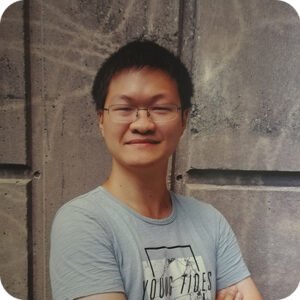Nanotechnology at Northwestern
Meet Hang Yuan, a graduate student in the Olvera de la Cruz Group
December 08, 2021
Hang Yuan is a graduate student in the Olvera de la Cruz Group. The group’s research is centered around the development of models to describe the self-assembly of heterogeneous molecules including amphiphiles, copolymers, and synthetic and biological polyelectrolytes, as well as the segregation and interface adsorption in multicomponent complex fluids.

Where are you originally from?
I am from Chongqing, which is located in southwestern China. It is partially surrounded by the Yangtze and Jialing rivers, in a mountainous area.
Where did you complete your undergraduate degree?
I completed my undergraduate degree in physics at Shanghai Jiao Tong University.
When did you first become interested in molecular dynamics?
I became interested in molecular dynamics simulation when I started my graduate study. Before that, I knew very little about molecular dynamics and was mostly interested in physics and computer science, especially the application of quantitative skills to solve problems in related subjects.
When I arrived at Northwestern, I quickly found that working on simulations of physical systems provided the perfect platform to combine physics and computer science. I enjoy the feeling that a simulation model in the silicon world can help with explaining or designing experiments in the real world.
How do you explain what you study to non-scientists?
The design of materials with desired properties and functionalities is a perpetual pursuit among scientists and engineers. By embedding materials that are responsive to external stimuli such as light, heat, and magnetic/electric fields into conventional passive materials, the responses of materials can be systematically engineered at hierarchical time and length scales.
As for my research, I used computer simulations and theoretical tools to study active soft material systems at various scales, including superparamagnetic nanoparticles, magnetic colloidal particles, and light-responsive hydrogels with magnetic components. This work is focused on understanding fundamental mechanisms of active soft material systems, especially the coupling between different physical phenomena. Ultimately, it aims to guide the synthesis of new soft materials and help the design of materials with targeted functionalities such as drug delivery, robotic motions, and actuation.
To give you a better idea of such materials, I recommend taking a look at the videos of our hydrogel robots.
What inspired you to focus on understanding the robotic behaviors of soft materials, and what do you hope to achieve?
Biological systems in nature have always been a great source of inspiration for me. I find it fascinating that living creatures like bacteria can respond to external stimuli such as light, chemicals, and heat to intelligently guide their motions. If we can design materials with similar intelligence, it will help us create bio-compatible machines with controllable behaviors to accomplish tasks at microscopic scales.
Soft materials generally have mechanical properties that are similar to biological systems and exhibit great biocompatibility. Besides, soft materials can be easily integrated with various responsive components such as magnetic particles and light-sensitive molecules. Magnetic responses are of great interest because magnetic fields can safely penetrate biological environments and are also widely accessible in commercial devices. Therefore, I chose to focus on exploring the emergent behaviors of those magnetoelastic materials.
With the help of computer simulations, I was able to elucidate the coupling mechanism between magnetics and elasticity at both the molecular and continuum scales. The fundamental understanding of the mechanisms in turn helps construct computational models, which is useful for predicting deformation of materials under the influence of external magnetic fields and designing more complex robotic functionalities.
In the long term, I hope to design self-powered autonomous soft robots with the ability to communicate with surrounding environments and neighboring robots. These soft robots are envisioned to be like full synthetic versions of their biological counterparts but can be commanded to execute programmed tasks in a biological environment.
What has been a highlight of your time at Northwestern?
When I go through my memories at Northwestern, I find it’s difficult to identify a single highlight, as many unforgettable moments rush into my head. It might be the night I could not sleep because my simulation model finally worked, or the moment I learned that my paper was accepted, or the celebrations when I figured out problems with collaborators and colleagues.
And those days and nights when I hung out with my friends would also definitely be the highlights.
What has been the most challenging aspect of your work or your time at Northwestern?
I think the most challenging thing is to frame the problems properly and figure out the appropriate methodology to solve them. Since I collaborate closely with experimental groups, it’s important to identify the essential physics in the experiment system and convert it into proper theoretical or numerical models. This process is difficult, and I have benefited a lot from discussion with brilliant collaborators and professors.
Can you tell me about your experiences either being mentored or mentoring others?
I had great experiences being mentored by incredible professors and colleagues. When I have difficulties in simulation techniques, I can always find someone in the group and get referred to proper resources. Besides, I am fortunate to have opportunities to interact with different research groups, which helped me see how problems can be interpreted from different perspectives.
I also got great mentor experiences from participation in conferences, where I got advice about professional development and exchanged ideas with experts in the community.
As for my own mentoring experiences, I feel very satisfied when I can explain a problem to someone did not know it before. I have also enjoyed presenting short tutorials of simulation techniques to my group members and participating in open-source projects.
What are your hobbies outside of the lab?
Outside the lab, I enjoy watching movies, reading books, doing workouts, checking out delicious food, and traveling with friends.